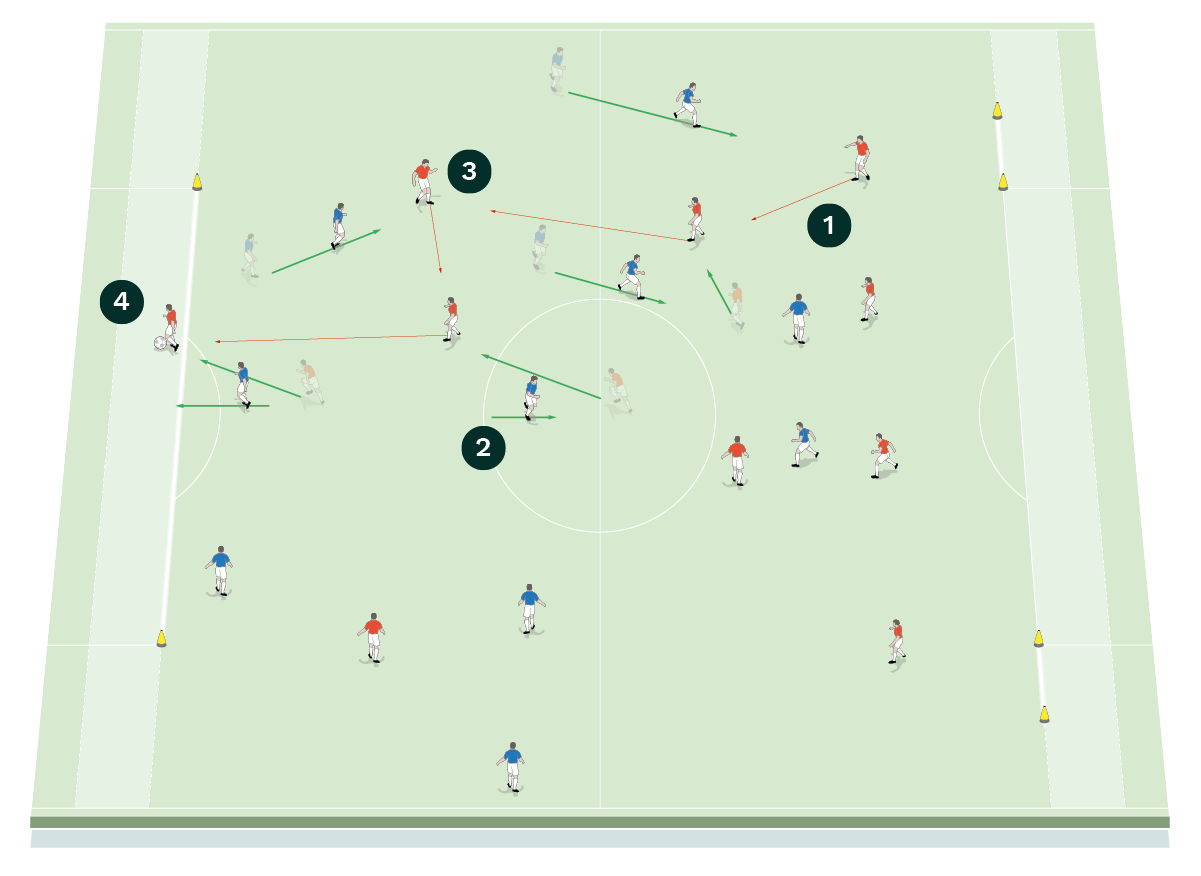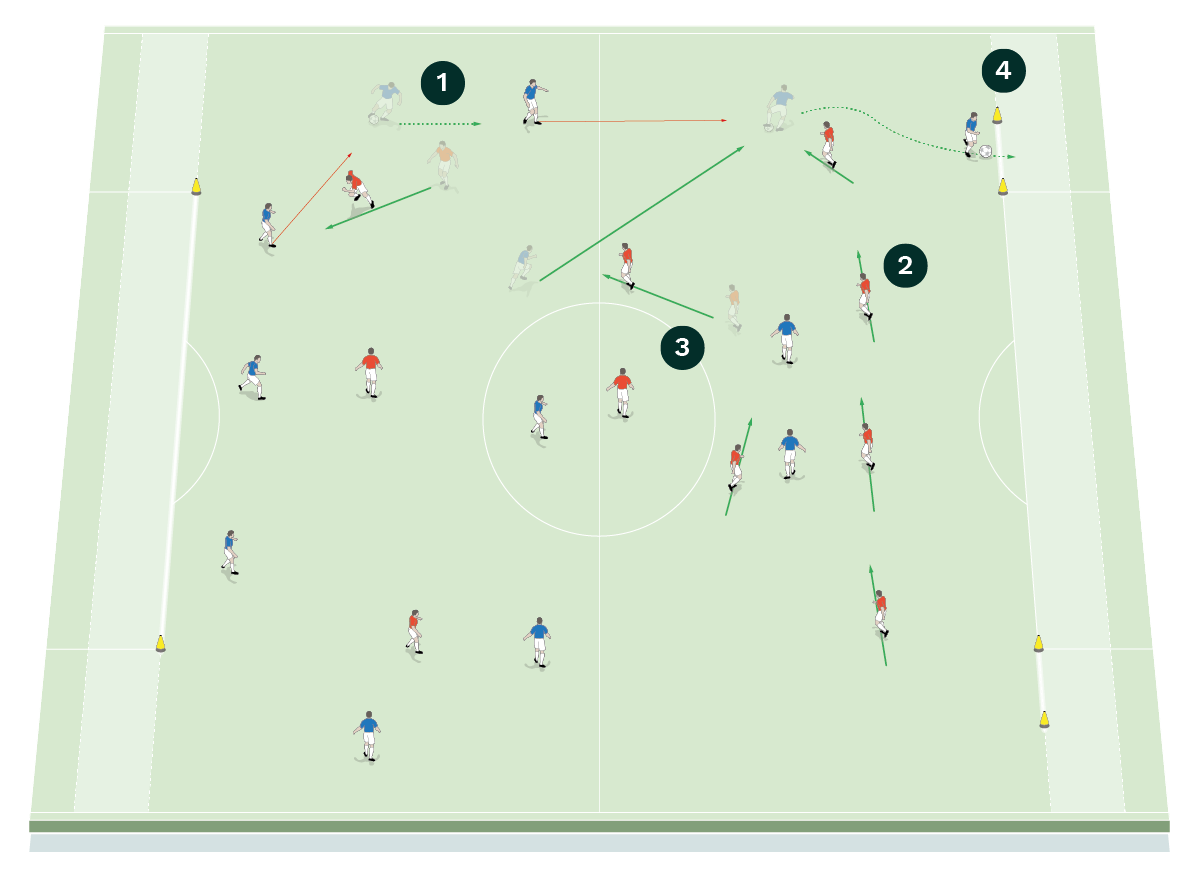Attacking and defending in wide and central areas
The FA’s foundation-phase lead PETE STURGESS on the key message behind England’s drive to get more youngsters comfortable and creative in possession

| Area | Up to full pitch |
| Equipment | Balls, bibs, cones, 2 full size goals |
| No. of Players | 20 players + 2 goalkeepers |
| Session Time | Wide and central attacks: 30mins Progression: 30mins |
In this session two teams work on attacking and defending in wide and central areas of the pitch. From an attacking point of view, it encourages the team in possession to quickly pass the ball forwards to set up an attack either centrally or in a wide zone.
I like this session because it covers so many topics, such as positive forward runs off the ball and positive forward passes from an attacking perspective.
Defensively one of the teams has to concentrate on swinging from side to side while defending the wide zones and the other team, who are defending the central zone, must concentrate on being compact and difficult to break through. We could also add passing restrictions if we want to work on maintaining possession, or we could promote a small number of passes to encourage players to make the early forward pass to set up an attack.
I would run this session once or twice a week as it’s a good session to do before a game, especially if we set up one team in our formation and the other team in the expected formation of our forthcoming opponents.
“From an attacking point of view, this session encourages the team in possession to quickly pass the ball forwards”
WIDE AND CENTRAL ATTACKS
We create a central zone between the two penalty boxes of a normal pitch, using its full width. An end zone of six yards is added at both ends. Leading into the end zone at one end are two small cone gates, one on either side of the penalty area, while the other end zone has one large gate leading into it, which is the width of the penalty area.
We are using 20 outfield players, with the red team set up in our team’s regular formation, in this case 4-3-3, and the blue team is set up in the formation the team we are set to play in our upcoming match, which here is 5-3-2.
The red team starts by playing out from the back and the reds are attacking the end with the single large gate. To score a point, they must run or pass the ball through the gate and stop it in the end zone. The blue team must therefore defend the middle zone by being centrally compact and leaving no gaps, as shown [1a], while the reds should be encouraged to pass forward early and quickly as they are up against a back five.
[1a]

- The red team starts by playing out from the back. They must keep possession while building an attack on the end with the single large gate
- As the reds are attacking centrally, the blues must defend the middle zone by being centrally compact and leaving no gaps
- The reds are encouraged to pass forward early as they are up against a back five
- To score a point, the reds must run or pass the ball through the gate and stop it in the end zone
When the blue team wins the ball and they are in possession, they must look to play the early ball down the sides to attack the end with the two small gates. They must run or pass the ball through one of the gates and stop it in the end zone to score a point, as shown [1b].
[1b]

- When the blues are in possession, they look to play the early ball down the sides to attack the end with the two small gates
- As the blues are attacking wide, the red team must concentrate on using a side-to-side defensive shuffle to block the blues
- The red defensive unit relies heavily on the support of their two central defensive midfielders
- To score a point the blues must run or pass the ball through one of the wide gates and stop it in the end zone
“The blues must run or pass the ball through one of the gates and stop it in the end zone to score a point”
The red team must therefore concentrate on a side-to-side defensive shuffle to block the blues and they rely heavily on the support of their two central defensive midfielders.
A condition can be added if necessary, requiring more passes to be made before a team is released to attack the gates. This encourages a team to maintain possession before they can attempt to score a point. Alternatively, teams can be conditioned to make less passes to encourage the early pass forward to score a point.
After playing for 15 minutes, the teams swap ends so both teams experience attacking and defending in different styles and we play for another 15 minutes.
PROGRESSION
We set up on a full size pitch with a goal and a goalkeeper at both ends. We recreate the restrictions of the previous practice by coning off one end into a funnel where the central gate had previously been and we use cones to create an attacking channel on either side of the opposite penalty area, recreating the small gates of the previous practice, as shown.
We’re using 20 outfield players split into two teams of 11 including goalkeepers. The red team sets up in our team’s regular GK-4-3-3 formation and the blue team sets up in the formation the team we are set to play in our upcoming match – in this case GK-5-3-2.
We play a normal 11v11 game. The red team starts play with a pass from their keeper and they are attacking the end where play is funnelled into the central area. They gain a point by scoring a goal, as shown [2a].
[2a]

- The red team starts play with a pass from their keeper
- The reds are attacking the end where play is funnelled into the central area and they gain a point by scoring a goal
- As the red attack is funnelled centrally, the blues should remain compact and try to be difficult to play through
If the reds score or the ball is dead, play restarts from the blue keeper and the blues try to score at the end with the two wide attacking channels. They are encouraged to attack through one of the wide channels and then cross the ball into the penalty area, where attacking team mates should be making supporting off-the-ball runs to finish on goal. If the blues score a goal from a cross supplied from the wide channel, as shown [2b], they gain a point.
[2b]

- If the reds score or the ball is dead, play restarts from the blue keeper
- The blues build an attack and try to score at the end with the two wide attacking channels. If they score a goal from a cross supplied from a wide channel, they gain a point
- Supporting attackers should be making off-the-ball runs to meet the cross and finish on goal
“The blues are encouraged to attack through one of the wide channels and then cross the ball into the penalty area”
After playing for 15 minutes, the teams swap ends and roles and play for another 15 minutes.
COACHING POINTS
What are the key things to look out for?
When attacking we want to see players supporting the attack by making well-timed forward runs off the ball. We also want players to show us they have the confidence to make the kind of perfectly-weighted killer pass that can create a goal scoring opportunity.
When defending centrally, we want players to remain compact. We also want to see players communicating with each other so they leave no gaps that can be penetrated.
When defending wide areas, we want to see the defensive unit shifting from side to side to delay the attacker with the ball. We also want to see the central defensive midfielders supporting the defenders.
What are the typical mistakes players might make and how do I avoid them?
When attacking, players don’t always take care of the pass as well as they should do and sometimes attackers can ball watch and fail to make the necessary supporting forward runs. Players can also tend to recycle the ball instead of making the positive pass forwards. What we want to see from the players is good pass appreciation, especially around the penalty area.
When defending, players can switch off and forget to track runners. They can also fail to get the swing right when shuffling across as a unit and they end up leaving gaps that can be exploited.
Editor's Picks
Attacking transitions
Deep runs in the final third
Using the goalkeeper in build-up play
Intensive boxes drill with goals
Penetrating the final third
Creating and finishing
My philosophy
Pressing initiation
Compact team movement
Coaches' Testimonials

Alan Pardew

Arsène Wenger

Brendan Rodgers

Carlos Carvalhal

José Mourinho

Jürgen Klopp

Pep Guardiola

Roy Hodgson

Sir Alex Ferguson

Steven Gerrard
Coaches' Testimonials

Gerald Kearney, Downtown Las Vegas Soccer Club

Paul Butler, Florida, USA

Rick Shields, Springboro, USA

Tony Green, Pierrefonds Titans, Quebec, Canada
Join the world's leading coaches and managers and discover for yourself one of the best kept secrets in coaching. No other training tool on the planet is written or read by the calibre of names you’ll find in Elite Soccer.
In a recent survey 92% of subscribers said Elite Soccer makes them more confident, 89% said it makes them a more effective coach and 91% said it makes them more inspired.
Get Monthly Inspiration
All the latest techniques and approaches
Since 2010 Elite Soccer has given subscribers exclusive insight into the training ground practices of the world’s best coaches. Published in partnership with the League Managers Association we have unparalleled access to the leading lights in the English leagues, as well as a host of international managers.
Elite Soccer exclusively features sessions written by the coaches themselves. There are no observed sessions and no sessions “in the style of”, just first-hand advice delivered direct to you from the coach.









